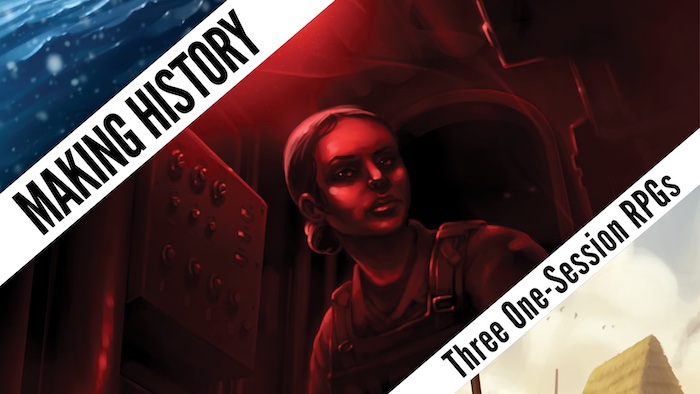In 1773, failed architect William Mylne fled his creditors in Scotland by absconding to the backwoods of the American colonies: a little shack outside Augusta, Georgia. He had a vision of setting himself up as a farmer, but a lack of funds and his own incompetence foiled his plans. He abandoned Georgia and traveled overland to New York hoping to find architecture work up there. He was no woodsman. He was an upper-class twit with no money on a grueling thousand-mile journey against the backdrop of the American Revolution. But it’s a remarkable setup for an RPG adventure. The PCs are hired by the banks to track down a guy who owes them a lot of money. He leaves plenty of evidence behind him as he goes. But he’s doing these wild things that can totally stymie the party. Is he some sort of backwoods genius trying to throw his pursuers? No! His constant mistakes just make him very hard to predict and to track. Let’s look at Mylne, his situation, and his wilderness misadventures.
This post is brought to you by beloved Patreon backer Justin Moor. Thanks for helping keep the lights on! If you want to help keep this blog going alongside Justin, head over to the Patreon page – and thank you!

Mylne was an upper-class architect from a long line of upper-class architects. His ancestors had been the royal architects of the kings of Scotland going back to 1481. In 1765, Mylne won a contract to build a bridge in Edinburgh. Mylne received a fixed sum of ten thousand pounds to build the North Bridge, and was thus obliged to produce the promised bridge, no matter what it actually wound up costing. But Mylne’s design wasn’t up to snuff. Right before the bridge was complete, as sightseers were walking along the bridge’s unfinished roadway, masonry vaults in the south approach collapsed. The earth that filled the vaults spilled outward, burying five people alive. Their bodies took days to recover. The government made Mylne disassemble other parts of the bridge so they could be inspected to determine if they too were at risk of collapse. Then Mylne had to rebuild those sections at his own expense. If they were found to be sound, he’d be reimbursed, but there was red tape and Mylne had to borrow a lot of money. Justifiable public concern drove more and more parts of the bridge to be torn down and rebuilt, year after year.
In 1773, Mylne had enough. He skipped town for London, then got on a boat for the Colonies. He left behind his creditors, his illegitimate son Willy, and his contractual responsibilities to Edinburg. William Mylne’s largest creditor was his brother Robert. It doesn’t seem like the family much liked the haughty and self-important Robert. In his letters, William refers to Robert as ‘his Honor’ and their sister calls him ‘the Pasha’. William actually bumped into Robert in London while waiting for the ship. William ducked out of sight to avoid an awkward conversation.
William Mylne landed in Charleston, South Carolina in late 1773. The ship he rode aboard, the London, was swiftly impounded. Mylne was walking into proverbial interesting times. The London carried a load of tea. This was the month of the Boston Tea Party. As the local government debated what to do with this symbol of British tyranny, Mylne skipped into the back country of Georgia, and moved into a pre-existing log cabin in the woods outside Augusta. He had with him some clothes, a little money, and his faithful dog Mungo.
Mylne was escaping, but he wasn’t making a clean break. He traveled under his own name. He sent his mother and sister his forwarding address. (Some of his letters have survived, which is how we know all this.) His creditors couldn’t hound him, as he was on the other side of the ocean and way back in the woods to boot. If Robert Mylne had cared to send someone after his wayward brother, it would have been expensive and time-consuming – but it would certainly have been possible.

Cabin living was a bad fit for Mylne. He had no experience growing corn or vegetables. He caught fish in the stream, but didn’t know how to preserve them. He couldn’t launder his own shirts, so he paid a homesteader to wash them for him. He sent his mother a pathetic letter in which he begged for money without trying to seem like he was begging for money. With fifty pounds, he could buy the ‘necessities’: waistcoasts, lapeled jackets, nightshirts, and the like. Oh and maybe he might be able to get some tools too, as an afterthought. With four hundred pounds, he could buy some land and some enslaved people to work it for him. Mylne’s neighbors found him a curiosity. They gathered for hours in his cabin to listen to his stories about the lives of fancy people. The word ‘fop’ was falling out of use in the late 1700s, but that’s totally what Mylne was: just some fop trying to make it in the back country.
In early 1774, Mylne left Georgia, bound for New York City. Homesteading didn’t agree with him. He thought he might find work as an architect up north. Normally, you’d do the voyage by ship. But Mylne was out of money and probably couldn’t afford the fare. The trip was 650 miles as the crow flies, but much longer along the ill-mapped, overgrown forest paths that passed for roads in the southern colonies. The roads may have been better maintained when the Native nations governed the area, but by Mylne’s time they were a mess.
Not long after leaving Charleston, Mylne came to a crossroads. Seated atop his faithful steed, he unfolded his map to see which fork to take. Either the crinkling of the map or something in the woods spooked the horse. It bucked Mylne off and ran into the forest. A mile down the road, it emerged where a helpful traveler encountered it and led it back to Mylne. But the horse’s saddlebag came off in its adventure – which shouldn’t be possible, so either Mylne didn’t know how to buckle them on properly or his ‘saddlebag’ was just a sack draped over the animal. The saddlebag contained Mylne’s shirts, so he spent an hour retracing the horse’s path through the woods to find the bag.

In North Carolina, Mylne got terribly lost traveling between Brunswick and Wilmington. At Brunswick, a passerby told him to stick to the main road for seventeen miles to Wilmington. Mylne rode on, but found the road forked at the tenth mile marker. He picked the broader of the two options. At the twentieth mile marker, when he was three miles overdue for Wilmington, Mylne concluded he’d picked the wrong fork. A sensible woodsman in unfamiliar terrain would have cut his losses, rode ten miles back to the fork, and continued along the other path. But Mylne instead decided to cut cross-country in the direction he thought Wilmington must lie. He wandered aimlessly through the woods until almost midnight, when he came upon a path. He followed it to an abandoned cabin with the roof caved in. He and his horse entered the cabin, he barred the door, and tried to get some sleep. But it was too cold and Mylne wasn’t dressed for it. He got no sleep that night.
In the morning, Mylne wandered aimlessly for five hours through the forest and swamps of coastal North Carolina. Then he came to the very same road he’d left the day before. He rode back down the road to the fifteenth mile marker and, not learning from his mistakes, rode off into the woods again. Surely this time he’d reach the other fork! Instead stumbled onto a path that he followed to a house, where he learned he was twelve miles from Wilmington – totally turned around. The people in the house gave Mylne directions and this time he actually managed to reach Wilmington without incident.
Mylne reached Philadelphia with only minor further incidents. He lost his dog, Mungo, but the local sheriff promised to look after the animal if he found it. While seeking hospitality at plantations and homesteads, he made friends – including a widow he was convinced wanted to marry him – and enemies – including a planter who’d give Mylne a bed but refused to stable his horse. In Philadelphia, Mylne sold his faithful horse so he could buy passage on a ship the last leg to New York. Mylne found no work in New York. The Revolution was underway, New York was in Patriot hands, and Mylne was clearly a Loyalist. Merchants wouldn’t accept letters of credit from his distant British family. Defeated, Mylne returned to London in September, 1775. He found work as an engineer in Dublin. The position offered him the money and respect he’d lost in Scotland. Eventually the red tape got sorted out, and Mylne paid off his debts or got his relatives to forgive them. He died in 1790.

In your fictional campaign setting, a bank might hire on your party to chase down an NPC based on Mylne. In real life, Mylne’s primary creditors weren’t banks. They were his relatives and the Edinburgh Council. But your fictional Mylne-analogue isn’t so lucky. He had to borrow from banks after his bridge disaster, then ran off to the woods without repaying them. The banks want him dragged back to the big city and thrown in debtor’s prison. There the poor little rich boy can beg his rich relatives to pay his debts to the banks so he can go free. Finding Mylne’s cabin isn’t hard. He’s in regular correspondence with his family, and he traveled under his own name. The party might pressure a relative to give up his address, might intercept a letter en route, might ask down on the docks where Mylne shipped out to, or might travel to the woods and ask around. All these avenues will get the party to Mylne’s cabin.
But your fictional Mylne-analogue isn’t at his cabin anymore! He can’t hack it in the back country and has left for another city. He doesn’t know the party is after him; the timing is coincidence. And now the party has to track him. In some ways, that’s easy. He’s still using his own name. He’s really distinctive, so the people he meets and lodges with will remember him passing through when the party asks if anyone matching his description came through here.
But when the party gets close to Mylne, tracking him gets harder. Take that business with the horse running off into the woods. Say you’ve got an Aragorn-type PC who’s tracking Mylne’s horse. The trail leads to a crossroads, where there’s some sort of scuffle with a bunch of crushed grass and churned-up earth, maybe even a little blood if the fallen Mylne cut himself on a rock. The horse goes straight into the woods and a new line of footprints goes down one of the paths. Which route do the players follow? In the woods, it’s all horse tracks, but then the same footprints appear from the opposite direction, leading the same horse tracks as before. The person retrieves something bag-shaped that was stashed in a bush, then returns following the first set of horse tracks. What was in that bag? Why was it hidden in the bushes? How did Mylne know about it? Sure, Mylne wasted time backtracking, but now maybe so are the PCs, so they’re not gaining ground on him.
And then there’s the business with taking the wrong fork. The PCs are following Mylne’s trail when he suddenly goes off-trail. Where is he going? What is he looking for? What’s so important about this ruined cabin that he went so far out of his way to reach it? And why did he reappear on the original road, backtracking for only a few miles?
This is probably only a single-session adventure. Once the party deduces that there’s no intent behind these decisions, that Mylne’s just a poor woodsman, there’s no point prolonging things. The PCs can just run ahead to where Mylne’s probably going and wait for him to catch up. In their off-road travel, you can throw in a monster attack or two (if your players are into that sort of thing) that Mylne narrowly and unknowingly avoided. It’s a fun change of pace, and then off to the next adventure!

I came across Mylne’s letters while working on a cool project for a Revolutionary War RPG called Nations and Cannons. You play as scouts, renegades, and light infantry skirmishers shaping the battlefield for the critical engagements of the Revolution. N&C is built on the bones of 5th edition D&D so it can reach a wider audience as an educational tool. The 5e framework also works remarkably well for light infantry skirmishes in the 18th century – surprising but true! I’m a major writer on Poor Richard’s Almanac and The American Crisis.
Make sure you don’t miss a blog post by subscribing to my no-frills, every-other-week mailing list! I also have a signup that’s only for big product releases!
Looking for material for your game tonight? My back catalog has hundreds of great posts, all searchable and filterable so you can find something from real history or folklore that fits exactly what you need! Posts older than a year are behind a very cheap paywall – only $2/month!
Come follow and chat with me on social media! On Mastodon I’m @MoltenSulfur@dice.camp. On Twitter, I’m @moltensulfur. On Blue Sky, I’m @moltensulfur.bsky.social.
Enjoy this post? Consider sharing it on social media, or maybe emailing it to a GM friend of yours. The social media infrastructure that creators relied upon to grow their audience is collapsing. You sharing my stuff helps me stay relevant and ultimately helps me get paid for my time.
Check out my book Making History: Three One-Session RPGs! It’s three awesome historical one-shots with pregenerated characters and a very simple rules system designed specifically for that story. Norse Ivory is a game about heritage and faith in the Viking Age. A Killing in Cahokia is a murder mystery in the Native American temple-city of Cahokia. And Darken Ship is a horror-adventure starring junior sailors on a U.S. Navy warship who wake up one morning to discover they’re alone on a ship that should carry three thousand.







